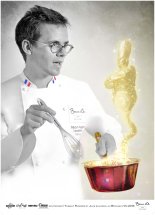Okishiba
- Details
- Category: Okishiba
- Published on 04 September 2013
- Written by Super User
- Hits: 7495

MADE BY OKISHIBA MASAKUNI, SAKAI
- OKISHIBA KNIVES
- The unbelievable tale of these unequaled knives
- Many years ago, I would hear, every now and then, a story about a Japanese bladesmith, Okishiba Masakuni, the Van Gogh of blades, also called “God of Blades” by other Japanese.
Okishiba Masakuni San became the smith of smiths in Sakai, the Japanese city in which work is often traditionally done by hand, until he died a miserable death of a liver disease twenty years ago, in 1990.
- Okishiba had become self-employed at an early age, after his 17-year apprenticeship to his father, the renowned bladesmith, Okishiba Masatsugu, and had opened a small forge in his house, as was and today still is often customary in Sakai. Within no time, Okishiba was getting the best prices for his products, which he would sell to the Association in Sakai, a customary practice at the time and one which is still often followed today.
- Okishiba was a lone wolf. No one, not even his wife, was allowed into his forge. All too early, this brilliant master bladesmith fell victim to alcoholism. He spent all his money on it. He worked in order to make money to buy alcohol. And yet, his blades remained unmatched. No other bladesmith manufactured knives of this quality. To date.
- Even today, stories are still told about Okishiba in the Sakai knife community. When he would pick up his money at the Association, his wife would be waiting at the ready outside, wanting to frisk him and relieve him of the money needed to run the household, etc. Okishiba would hide a good portion of his earnings in his stockings, since his wife never searched them. This way, he would have enough for alcohol.
Many three-star chefs are still working with Okishiba’s blades today, and they cost as much as 5 million yen. Used knives!
The knives don’t depreciate in value if they are used correctly.
New knives are unobtainable; Okishiba has been dead for twenty years. The head of the Association in Sakai, Mr. Shinoda Keizou, still has a few blades in his warehouse that he gives upon request to the best chefs in Japan, but to no one else. Officially, he doesn't give these out any more. The response to requests is that they are sold out.
- In the Japanese world of knives, the name ROMANOWSKI enjoys a very good reputation. I was the first to bring Japanese kitchen knives to Europe on a grand scale, and so became the first world-wide importer of such famous Japanese knife brands as Global, Chroma, and Kasumi.
- We made contact with the Association through CHROMA, our supplier, who also produces in Sakai. Shinoda Keizou, who never has a knife to spare under most circumstances, thought it a great idea that the best knives from Sakai should advertise for Sakai in Europe, and he has allocated to us nine (9) blades, perfected by the CHROMA team who also manufacture the outstanding HAIKU PRO and HAIKU ITAMAE Suminagashi knives (see URL at HAIKU’s web page). We had to promise not to re-export the knives to Japan to turn a quick profit; Okishiba’s knives are in extreme demand in Japan.
- There are presently nine of Master Okishiba’s blades in the west. One we will donate to a museum of Applied Arts. Others will go to other European countries as showpieces.
- And a small few can be purchased. The price amounts to 30.000 US $ per knife, including accessories. However, we wish to warn all buyers. Even though a Japanese master chef can cut a piece of paper into four in the air with the Okishiba knife, a European would have trouble cutting an apple with it. He might break off a piece of the blade, which has been ground extremely thin. Sharpening the Okishiba knife also requires a lot of experience. A Japanese sushi apprentice undergoes a training period of at least seven years. For the first three years, he does nothing other than clean the shop to show his humility, and grind his knife.
- Daily, and for hours. At this point, however, he wouldn’t have an Okishiba, just a normal hand-made, good value Sakai quality knife, such as the CHROMA HAIKU PRO. Out of sheer respect, he would not use the knife of a great master. Only in the course of years, of decades, will he buy better knives. Also, he will receive a good knife as a gift from his teacher at the end of his apprenticeship. If he has been a good apprentice, it may even be very old, perhaps one that his employer had once received as a
- gift. In this way, many knives are passed down through the generations.
- Why are these Okishiba knives in such demand? They are sharper than others and keep their sharpness longer. It’s that simple. Why are these knives so expensive? Supply and demand determine the price. There are almost no Okishiba blades to be had on the market, and yet they are in heavy demand in Japan.
- To any interested Western buyer, I would recommend purchasing an Okishiba knife only as a collector’s piece, not as a knife to work with, since its care is expensive and demands a lot of experience. It is a fascinating knife that you simply must get your hands on! Christian Romanowski




